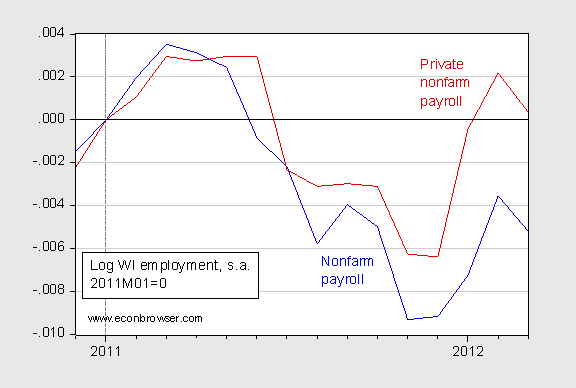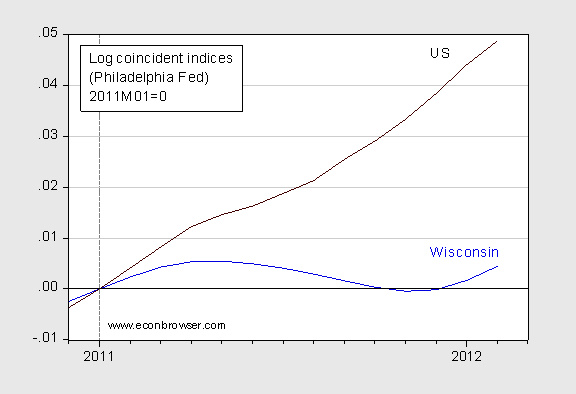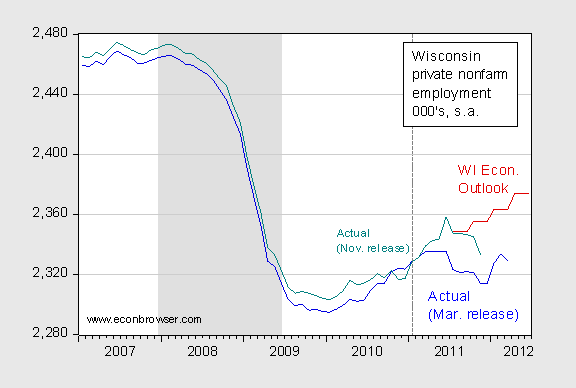
Figure 1
The red line is employment in the euro zone (seasonally adjusted, for 17 countries, from ECB). The blue line is private nonfarm payroll employment in Wisconsin (seasonally adjusted, average of monthly data). I discovered these interesting similarities as I was preparing for a panel presentation on the eurozone crisis this Wednesday. Policy makers in the euro zone are embarking upon continued austerity measures, reinforcing contraction, given fiscal multipliers are large in the presence of slack, and at the zero interest rate bound [1] (More on the euro crisis by Michael Klein). Since Wisconsin does not possess its own currency, it is not surprising to see lackluster growth (or contraction) in the face of fiscal retrenchment here as well (the downturn correlates well with the new budget year).
When I last evaluated Wisconsin’s macroeconomic status in early March [2], it appeared that employment was recovering, back to levels observed at the beginning of 2011. It now appears that might have been a transitory rebound.

Figure 2: Log Wisconsin nonfarm payroll employment (blue) and Wisconsin private nonfarm payroll employment (red), relative to January 2011. Vertical dashed line at 2011M01. Source: BLS and author’s calculations.
Private nonfarm payrolls have declined, and are essentially back to levels at the beginning of Governor Walker’s term. Nonfarm payroll employment is about half a percent below. Note that the apparent surge in Wisconsin employment back to 2011Q1 levels at the quarterly frequency masks a downturn in March.
February readings of aggregate activity, as summarized by the Philadelphia Fed’s coincident indices, confirm that Wisconsin has been treading water, on net, since January 2011. In contrast, the United States economy as a whole is now nearly five percent above January 2011 levels.

Figure 3: Log coincident indices for Wisconsin (blue) and for US (black), rescaled to 2011M01=0. Vertical dashed line at 2011M01. Source: Philadelphia Fed.
The Philadelphia Leading Index for Wisconsin suggests expansion in the next six months; however, prospects are less bright than indicated in January’s reading.

Figure 4: Log leading indices for Wisconsin (blue) and for US (black). Values greater than zero indicate expansion in the next six months. Vertical dashed line at 2011M01. Source: Philadelphia Fed.
The Wisconsin Department of Workforce Development statement regarding the employment report observes:
“Wisconsin’s March preliminary unemployment rate dropped to 6.8 percent, after holding at 6.9 percent for two months,” Secretary Reggie Newson said. “A year ago, the rate was 7.6 percent. With unemployment rates not this low since 2008, Wisconsin’s economic picture continues to improve.”
“In addition, the same BLS survey data show more people are working today than a year ago,” Secretary Newson continued. “Approximately 18,500 more Wisconsin residents are employed compared to March 2011.”
The household survey does indeed indicate an increase in employment. It is noteworthy that total civilian employment is 0.2 percent below January 2011 levels.
Figure 5 places private employment growth in the context of the Walker Administration’s forecast from the October 2011 Outlook.

Figure 5: Wisconsin private nonfarm payroll employment from BLS March 2012 release (blue), from BLS November 2011 release (teal), and projections from Wisconsin Economic Outlook (October 2011) (red), in 000’s. NBER defined recession dates shaded gray. Vertical line at 2011M01. Sources: BLS, Wisconsin Economic Outlook and NBER.
Note that the January 2012 benchmark revision reduced estimated employment relative to those used in generating the Wisconsin Economic Outlook forecast. That is, it turned out that employment growth in the first nine months of the Walker administration had been less than originally estimated.
In any event, this is Governor Walker’s current assessment, from Newsmax:
“I think the big thing that people are waiting for is to have the certainty of knowing that this sort of positive outlook for job creators is going to continue,” said Walker.
“That’s why I think that after June 5th, after these primaries are done, and when I and the lieutenant governor and these senators prevail, I think it means there will be a clear message to the job creators and the small businesses in the state that now is the time to add jobs,” he said. “And I think they will.”
Thanks Menzie. What a stark example of how government unions can counter good economic policy. Hopefully after the union recall is put to death Governor Walker can continue with his recovery program for Wisconsin.
It is pretty clear right now that Wisonsin is going through a serious crisis of conscience – should they follow the example of Illinois and enrich the unions at the expense of the citizens, or should they follow the examples of Indiana and allow the citizens to create recovery.
Your graphs are very illustrative of what is at stake.
fear, not, good people of Wisconsin. my RBC model says the citizens of the great land of cheese are merely taking much-needed time off to enjoy the fruits of their labor. Employment will soon return: If elected on June 5th, I the great Mouse King will send a message to all job creators to create jobs, and to all citizens to get back to work.
Dang, I guessed something to do with the output gap 😉
Menzie, as you prepare, keep your eye out for a timeline of due dates for large debt payments within the EU. This is relevant because if they are large, and in the near future, then they impose a timing constraint on policy. For example, it does little good to talk about higher tax revenues 5 years in the future for a country that defaults in 2 years. It seems a relevant projection would be treasury balance vs the due dates of debt/principal payments.
What would Wisconsin’s non-farm, non-government absolute employment and unemployment rates look like.
Dr. Hamilton’s chart from 2 days ago seems to indicate that Wisconsin’s employment situation is really not bad at all:
https://econbrowser.com/archives/2012/04/unemp_state_apr_12.jpg
A short-term adjustment for getting spending in line seems quite reasonable given the larger picture.
tj: While I think the information regarding debt service and rollovers timing is useful, bad timing not necessary or sufficient for crisis (or non-crisis if timing works out). The debt swap in Argentina is case in point.
Bruce Hall: Wisconsin has a state fixed effect in terms of unemployment, vis a vis the rest of the country (about a percentage point). Since you commented last time I made this observation, you should have noted this in your discussion of relative performance.
The part that bothers me is the comment from Gov. Walker: he speaks about business confidence as though the reason a business locates in or expands in Wisconsin is hugely rooted in marginal differences between government policies between Wisconsin and other states. Those reasons are a relatively small part of a business’ decision-making. You locate where you can make money. You expand because you can make money, either locally or through selling into another state or country.
For example, if I have to pay 1.5% more in taxes, those only come out of my net, meaning they at most reduce my return. If I have 100k in sales and have to make up 1.5k to justify locating in x rather than y, that is only important if there is nothing else on the table that matters. The difference just isn’t that much.
I picked this one example, but my point is that in all these policy decisions the differences aren’t that much. When the differences are larger, that’s because of differences in subsidy. Ohio subsidizes investment in distribution facilities while Michigan subsidizes investment in labor. Those are competitive choices, not one being better than the other.
When the Governor talks about business confidence, he’s saying he has no clothes.
Menzie,
I recall your historical comparison of Wisconsin to the U.S. average, but when you are looking at all 50 states, it would seem that you would have to adjust all of the states relative to their relationship to the average before you could meaningfully attack Wisconsin’s current performance. And then you’d have to analyze the unique current impacts on such performance; e.g., oil shale boom in North Dakota.
Regardless, it would appear that even if you gave Wisconsin a 1-pp penalty just for being better than average historically, that would place it somewhere in the middle of the spectrum rather than the worst third.
The larger question to resolve is whether the current hit to employment because of reduced government jobs is justified in terms of the fiscal future of the state. Seems too early to pronounce judgment.
Menzie,
I agree, not necessary or sufficient. However, it seems that policy decisions become clustered around those dates.
The most recent round of long run policy is beginning to be sucked in to the black hole of declining GDP growth and may be rendered inadequate and opens the door for inflating away the real value of debt, as you propose.
Troubled governments recently decreed that the masses relinquish portions of their income and entitlements. A new policy that promises to inflate away the real value of their remaining wealth, income and entitlements will not sit well with them. A potential for large negative externalities relative to the painless bailout they seem to expect.
What fraction of government spending in these countries is indexed to inflation so that more inflation = more government spending?
Challenging times for you as a policy maker/analyst.
Jonathan,
I would challenge you to take a look at US Steele and Standard Oil to analyze how they became so successful. As a hint think about John D. Rockfeller collecting drops of solder to reduce the cost of manufacturing barrels. When you write “…my point is that in all these policy decisions the differences aren’t that much,” you simply prove that you do not understand how America became an economic powerhouse.
Ricardo, absolutely right, and I’ll add a few more examples of cost awareness from a large telecom company I used to work for. They had tax rate data on every European country to four decimal places. Printed circuit board costs from every large manufacturer in the world were tracked weekly to $0.0001. Meeting costs for large national conferences were analyzed – transportation, hotels, food. (Orlando was cheapest.) 100’s of people were doing these calculations. When people say companies worry about a penny in costs, BS. They worry about thousandths of a penny.
Ricardo As a hint think about John D. Rockfeller collecting drops of solder to reduce the cost of manufacturing barrels.
Was this really the best use of Rockefeller’s time? Maybe he wasn’t as smart a businessman as I thought.
There isn’t a whole lot that a governor can do to improve things during a cyclical downturn. Governors can do a lot of things to improve structural unemployment, but not much to improve cyclical unemployment. Cyclical unemployment is a national problem. But just because a governor cannot do much to improve things during a cyclical slowdown, that doesn’t mean a governor cannot somehow make things worse. And that’s exactly what Gov. Walker has managed to do. And one of the surest ways to make things worse is to try and treat a cyclical problem with “supply side” structural cures. That’s also what the EU has been trying to do, and this could go a long way towards explaining the similar time series charts.
Slug wrote:
Ricardo As a hint think about John D. Rockfeller collecting drops of solder to reduce the cost of manufacturing barrels.
Was this really the best use of Rockefeller’s time? Maybe he wasn’t as smart a businessman as I thought.
Slug,
Do you really want to go there, even in jest?
The aggregate economist fails because from 10,000 ft above the ground he simply can’t see brilliance of actual commerce or the tragedy of waste. Criticism of the successful because their brilliance cannot be seen from 10,000 ft reveals much, requiring no comment.
From Rich States, Poor States by Art Laffer, Steven Moore, and Jonathan Williams, 2012.
2slugbaits,
Ricardo’s apocryphal point about Rockefeller and solder was apropos. Elimination of waste [not poop for the sophomoric] can reap substantial rewards in business and government.
Major government health care programs run between 10-20% fraud and abuse according to Cato and Harvard University’s Malcolm Sparrow estimates that improper payments account for 20 percent of spending in federal health care programs.
Ford Motor Company’s commitment to six-sigma was a commitment to eliminate waste with higher quality as a process product.
It is far easier to go for zero waste than 100% market share. Likewise, it is far easier to go for zero waste than constantly rebalancing a work force and budgets. Eliminating waste could significantly assist governments in paying for perceived needs.
Ricardo & Bruce Hall First, my comment about Rockefeller didn’t have anything to do with “aggregate” economics “from 10,000 ft above the ground.” In fact, it is based in micro 101. It’s a basic misallocation of resources. Hunting for waste is in itself a wasteful process. And as to Ford Motor Company’s commitment to Six Sigma (actually I think it was a Motorola idea, but never mind), the usual buzzword is “Lean/Six Sigma,” which means taking non-value added processes out of the production process. Having people check for too much solder is the complete opposite of Lean/Six Sigma principles. Six Sigma was about incorporating quality into the production proces and not about incorporating quality police checking after-the-fact.
Your examples from the Laffer, et.al. paper is a exactly what I mean by not knowing the difference between cyclical and structural problems and not knowing when to prescribe the right medicine. Even if all of Wisconsin’s structural budget problems could be blamed on unions and inflexible regulations, it does not follow that fixing those things is the right thing to do during an economic downturn. Laffer’s praise for communities and school districts that are currently running fiscal surpluses is idiotic and clueless. The time to fix structural problems is when the economy is at full employment. That’s the time to cut back spending and increase taxes. Of course, that’s also the time when we hear GOP politicians talking about the need to cut taxes during the good times and how it’s only when the economy is strong that can we “afford” the luxury of government spending. This has it completely backwards. What you are praising are pro-cyclical policies. Pro-cyclical policies make a lot of sense if you’re running a business or household; they make no sense whatsoever if you’re running a government entity. And if you don’t understand why governments should be counter-cyclical, then I have no idea why you even bother visiting this site.
BTW, as to the claim that government healthcare programs run 10%-20% fraud…keep in mind that for every fraudulent government transaction there is an equally fraudulent counterparty transaction on the private sector side.
“Milwaukee taxpayers have saved $25 million just from the increased employee health and pension contributions imposed by the state.”
Those “savings” were imposed by the guy that is most likely to run against Walker. Oh, the irony!
Isn’t it interesting that the unions aren’t able to get their preferred candidate through the primary? Isn’t it interesting that even on the D side, the likely candidate is from conservative Milwaukee instead of Communist Madison?
“Since Wisconsin does not possess its own currency, it is not surprising to see lackluster growth (or contraction) in the face of fiscal retrenchment here as well (the downturn correlates well with the new budget year).”
A comparison between Wisconsin and the euro zone economies with respect to the effects of austerity seems particularly inappropriate. If Wisconsin exercises expansionary fiscal policy, it seems to me the bulk of the effect would likely just flow outside its borders. The same would be true (although perhaps to a lesser extent) for any individual member of the euro bloc. For the bloc as a whole, a bigger part of the effet of austerity by any individual member will be felt somewhere within the bloc, even if little is felt in the member itself.
don,
Your quote from Menzie is particularly amusing. The implication is that if each state only had its own currency it could inflate away all its debts and all would be well with the world. GULP! Can you imagine if every state had its own currency?!